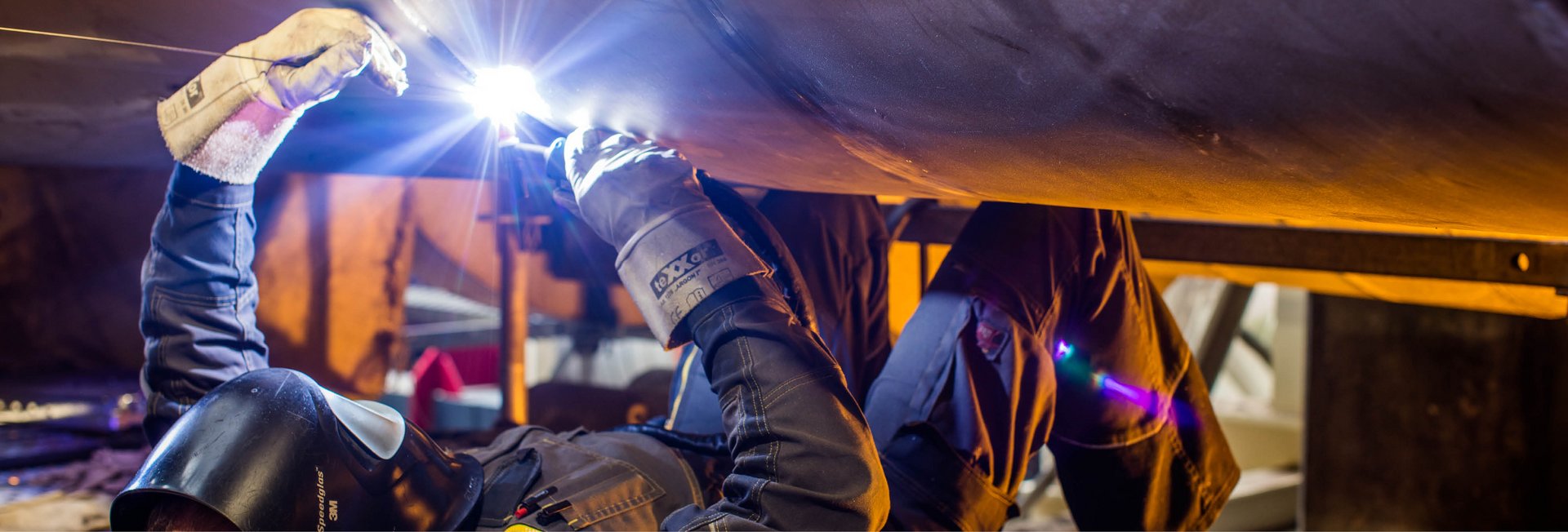1.500
ISOProcedure qualification tests according to DIN EN ISO regulations

Welding technology
Welding stainless, special and clad materials is one of BUTTING's particular areas of expertise. As a specialised welding company, we are certified in accordance with ISO 3834 (Part 2) with regard to "comprehensive quality requirements". Thanks to the continuous development of our processes, we fully comply with the increasing demands of the market at all times.
Around 1,500 weld procedure qualifications are proofn of our qualification in accordance with ISO 3834 (Part 2). At BUTTING, 480 welders tested and certified in accordance with national and international regulations are available to meet the highest demands, as well as 150 welders and 45 welding operators in accordance with ASME IX.
Procedure qualification tests according to DIN EN ISO regulations
Procedure qualification tests according to ASME IX regulations
Procedure qualification tests according to other regulations
This is our top performance
State-of-the-art-equipmente, outstanding craftsmanship and many years of experience are the hallmarks of our expertise in welding technology. We use all common arc welding processes and laser beam welding processes (laser beam and electron beam).
Submerged arc welding is an arc welding process that takes place under flux. The arc burns between a consumable electrode (also the filler material) and the workpiece. Possible materials are unalloyed and low-alloy CMn steels, and with regard to fine-grain steels mainly the API grades X52, X60, X65 and X70.
GMAW welding is an arc welding process using shielding gas. The arc burns between a consumable electrode (also the filler material) and the workpiece. MIG welding offers 2 different variants: metal active gas welding (MAG) or metal inert gas welding (MIG).
The economical range of application at BUTTING relates to joint welding in all positions from a wall thickness of 3 mm.
Possible materials are alloyed and unalloyed steels, CrNi steels, nickel alloys, aluminium, copper materials and copper alloys.
TIG welding is an arc welding process using shielding gas. The arc burns between a non-consumable tungsten electrode and the workpiece. The process can be used with or without filler metal.
The economic range of application for BUTTING refers to welding in all positions from a wall thickness of 1.5 mm.
Possible materials are unalloyed and low-alloy CMn steels, stainless steels, nickel alloys, copper alloys and non-ferrous metals.
Plasma welding is an arc welding process using shielding gas. The arc burns between a non-melting tungsten electrode and the workpiece. In contrast to TIG welding, the arc is strongly constricted by a water-cooled copper nozzle, which enables an increase in energy density and therefore allows the welding of thicker walls. The process can be used with or without filler material.
The economical range of application at BUTTING relates to joint welding mainly in the PA position (trough position) up to a wall thickness of approx. 8 mm without special weld preparation.
Possible materials are stainless steels, nickel alloys, copper alloys and non-ferrous metals.
Electron beam welding is a beam welding process and takes place in a vacuum. Electrons are generated at the cathode and accelerated in the direction of the workpiece to be welded. This focusses the electron beam, which increases the energy density. When the electron beam hits the workpiece, the electrons are abruptly decelerated. The resulting heat is used to melt the workpiece to be welded. The process can be used with or without filler material.
The economic area of application at BUTTING relates to the production of longitudinally welded pipes with greater wall thicknesses (from 3 mm to 80 mm depending on the material).
Laser beam welding is a beam welding process using shielding gas. By focussing the generated laser light (forced emission of radiation), an extraordinarily high energy density can be generated at one point. The energy generated in this way is used to melt the workpiece to be welded. The process can be used with or without filler material.
BUTTING's economical range of application relates to welding- predominantly in the PA position (trough position) from a wall thickness of 1 mm to 4 mm without special weld preparation.
ES welding is a resistance welding process that takes place under flux. After the welding flux has been melted by an initial arc between the melting electrode (also the filler material) and the workpiece, the arc is extinguished. The current now flows from the electrode via the liquid slag and the molten metal to the base material. The resistance heating of the slag melts the filler material and melts the weld flanks.
The economic application range for BUTTING relates to cladding welding, predominantly in the PA position (trough position) with a cladding thickness from approx. 2 mm in case of longitudinally welded, clad pipes.
Possible materials are stainless steels and nickel-based alloys as cladding material for metallurgically clad pipes.
This is a typical medium-contact welding process for clad pipes, which has a lower degree of dilution with the base material and a high melting performance.
Consistent quality, high productivity and safety in the workplace are some of the major challenges in welding. A high degree of mechanisation/automation through the use of robots helps to meet these challenges.
In robotic welding, welding is carried out on the basis of a programme. The programme can be adapted depending on the component / welding task. Welding is carried out by the machine, but the process is still controlled and monitored by the welder. Robots are able to reach otherwise inaccessible areas and can perform complicated and precise weld seams.
Robot welding is used at BUTTING in the TIG and GMAW welding process for repetitive welding tasks.
Possible materials are alloyed and unalloyed steels, CrNi steels, nickel alloys, aluminium, copper materials and alloys.
This welding process is very economical, has a high degree of mechanization, shows very good qualit resultsy, has a very good reproducibility, is suitable for the production of small to large series and enables complex welding tasks.
Continuous improvement of welding processes
Robot welding: Our fully automated welding cell is combined with a robot system and set up for both TIG and MAG welding of components. With optical weld tracking during the welding process, we ensure uniform, excellent weld quality. Depending on the requirements, components are completed using manual, semi-automated and fully automated welding processes.
Cladding welding: The plasma powder process modified by BUTTING has been used for the cladding welding of riser pipes made from roll-bonded API 5L X52 / Alloy 825 since 2001. In 2009, a new cladding process was introduced in the form of electroslag welding. This enables us to carry out weld cladding on 12 metre pipes with an internal diameter ≥ 174 mm.
Realisation of the most diverse specifications
We use Plasma, TIG and Laser beam welding processes to manufacture pipes from coil. For the production of pipes from plates, we use Electron Beam Welding in addition to Plasma and TIG welding due to the generally higher wall thicknesses. However, submerged arc welding, GMAW processes and electroslag welding can also be used.
We also focus on the continuous development and improvement of our welding processes and can therefore respond to the specific requirements of your project at short notice. To this end, we constantly liaise with our suppliers and customers and participate in research projects and welding technology events.
When is which weld procedure used?
At BUTTING, the decision which weld procedure is used for your specification is based on economy, feasibility and quality. Here you will find some examples of weld procedure for the various applications of our products:
Areas of application
|
Typically used weld procedures
|
|---|---|
Seawater desalination
|
GMAW, TIG, Plasma
|
Oil and gas
|
TIG, Plasma, UP, ESW
|
Pneumatic conveying
|
TIG, Plasma, LBW
|
Pump technology
|
TIG, Plasma, LBW
|
Well construction
|
GMAW, TIG, Plasma, EBW
|
Architecture & Design
|
TIG, Plasma, LBW
|
Hydrogen
|
GMAW, TIG, Plasma, EBW
|
Geothermal energy
|
TIG, Plasma, LBW
|
Solar technology
|
TIG, Plasma, LBW
|
Nuclear technology
|
TIG, Plasma, EBW
|
Pigging technology
|
TIG, Plasma, LBW
|
